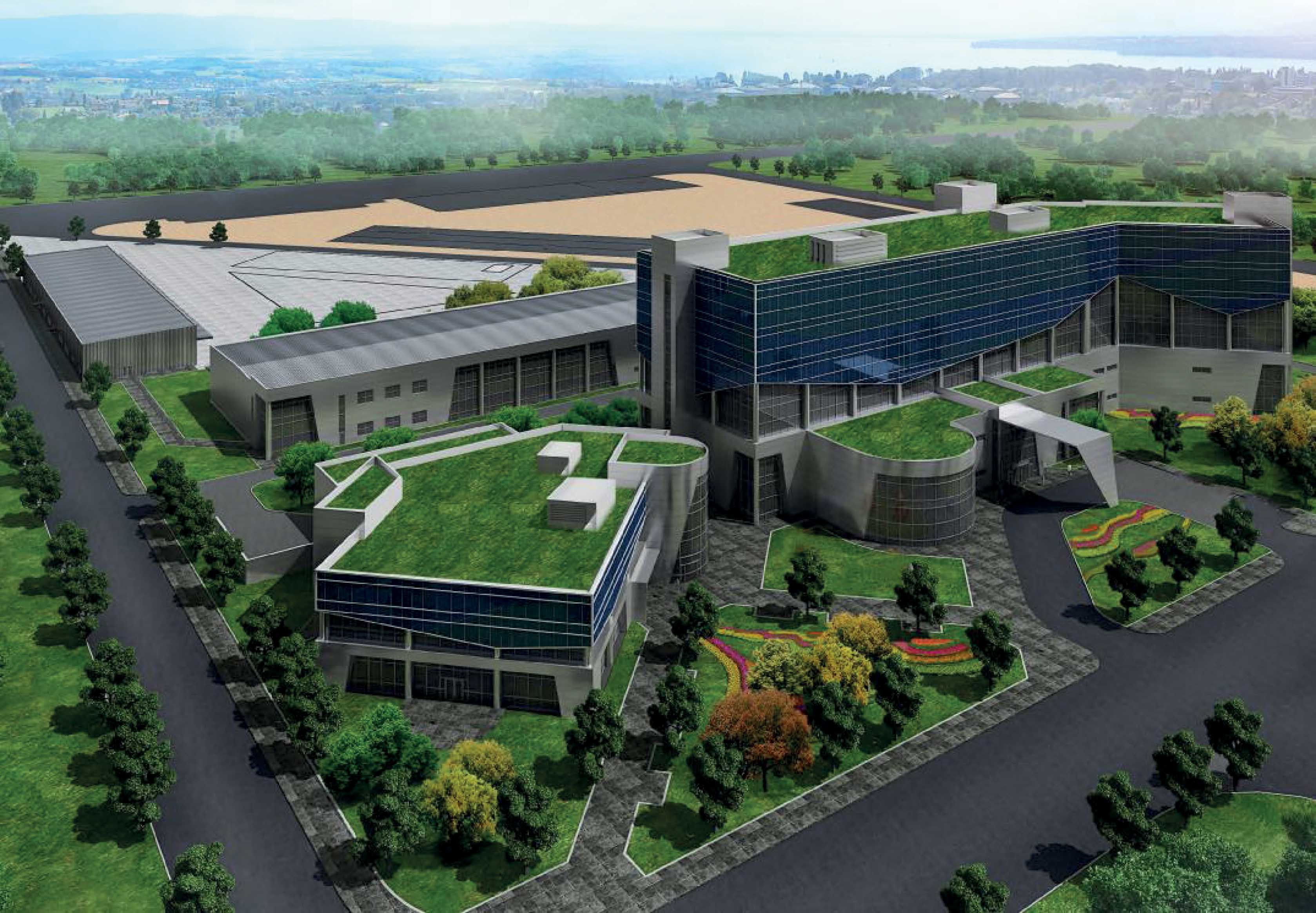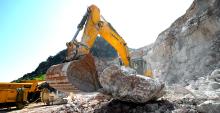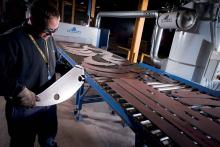
LiuGong is due to open its multimillion dollar research and development centre next to its Liuzhou, south China HQ in June 2015. Guy Woodford spoke to David Beatenbough, LiuGong’s vice president for R&D, about how the completion of the cutting-edge facility will enhance the major construction equipment manufacturer’s ambitious product development plans.
Seven state-of-the-art testing laboratories that allow for any advanced product testing, a fully-equipped prototype workshop, and an ultra-modern office building able to house 1,300 engineers and support staff.
It’s easy to see why
“It’s very exciting. There’s not many engineers that have the opportunity in their careers to develop a facility such as this. It’s quite a thrill to go through the process from beginning to end.
“When planning the R&D site, we visited several sites within similar industries, like agriculture and trucking, analysed the products we build and where our strategic direction is heading, and figured out what we needed.”
Costing US$44 million (RMB 270 million) and covering an area of 110,000m², Beatenbough is excited about the extent to which the new R&D centre will enhance LiuGong’s already extensive product development programme.
“Most of our testing we do within our current facilities is done not nearly as efficiently as we’ll be able to with the new facility. We currently have to build a lot of dedicated test stands. We finish the test and then there’s a lot of scrap iron. With the new site we’ll be able to set up for the test, finish it and then rearrange the fixture and go for another test.
“As well as being more efficient, it allows us for the first time to gather all our specialists and experts in the same location. Communication goes on today between locations, through email and other means, but it’s not very personal. The idea exchange when you go two doors down in the same building and talk to somebody is so much better.”
Beatenbough believes the opening of the R&D centre is “very important” to LiuGong’s future and the company’s ability to compete with other leading international market OEMs. Having a modern and attractive office building will, he says, make it easier to recruit engineering talent. He says the prototype workshop will also give LiuGong control over quality and other factors as its engineers work on experimental machines.
“The prototype workshop will allow us to fabricate parts. We can start with plain steel and cut, form and weld whatever we need. We’ll be able to measure the parts, machine them and then wind up with a hand-built part that matches our drawings and requirements. With the assembly process used in the prototype workshop every step is checked and every bolt is torqued and marked off, so you know whenever you’ve finished building a machine you know it meets quality standards. It means when you go to test it you’re testing the design, you’re not hindered by assembly errors.”
The scope of the new well-equipped test labs at LiuGong’s new R&D centre is comprehensive, as Beatenbough explains.
“It’s a collection of seven different labs, attached to each other in one big building. One of the big labs we’ll have is the noise and vibration laboratory, which will be housed in an anechoic chamber. It will have all the equipment we need to locate noise source, to analyse noise frequency, and to complete any noise investigation. It will be a chamber big enough to put in our largest machine and what we foresee as our largest machine in the future.
“We’ll also have a heat balance lab, which will allow us to achieve true operating conditions for loading, and analyse all our machines’ cooling system performance. We’ll have engine dynamometer test cells so we can monitor engine performance under a variety of conditions; a cold room so we can simulate freezing temperatures, such as in the Russian winter; and a structural fatigue lab to allow us to do accelerated testing of any steel structure to determine the durability of machines. We’ll also have a materials’ science lab which will allow us to do analysis on not only steel, but also on plastics and fluids.”
So when are customers likely to see the first new models based on work done at the new R&D centre come onto the market?
“Once the centre is open we’ll start using it for everything we are working on,” says Beatenbough. “We’ve got projects that are nearly complete, with the last part of their testing and development done in the new R&D centre. There’ll be things coming out that the R&D centre has touched by the end of 2015, including more models from the H-Series wheeled loaders. The H-Series models will also continue to come out in 2016, and the next generation F-Series excavators will be out in 2017 and 2018.”
Beatenbough stresses that the LiuGong models coming to market over the next few years will be aimed equally at international and domestic customers. “Some of the models will be common. For more advanced markets, the models we produce will be more wary of reducing things like vibration and noise levels. This is where our new noise and vibration laboratory will be used. On wheeled loaders, we’ll be looking to add models both upwards and downwards [in tonnage]. We’re also going to be producing new mining truck models.”
A successful and global construction equipment industry wide respected engineer in his ninth year working for LiuGong, Beatenbough says that the company has a “little bit of a different philosophy” to other companies when it comes to recruiting its engineers, reflected in the 700-800 engineers and support staff who will initially work in the new R&D centre.
“I like to bring experts in, not to specifically run a project, but to have them create other experts. We’ve been bringing on board world class talents in specific areas of engineering. They work on projects, but the main thing I want to see from them is developing our younger staff, our Chinese engineers, so they become experts themselves. This process will continue with the new R&D centre. We are in a cyclical market but over the medium to long term, the 700-800 engineers and support staff at the centre will double. We do a lot of active recruiting from universities, especially from those here in China. Some universities are specialists in heat transfer technology, others in structures. We go to the engineering course leaders looking for their young people with the basic skill set that we need and we bring them in to our LiuGong culture and develop them from there.”
Existing and newly recruited engineers and support staff, including those from Chinese and non-domestic universities, for the new R&D centre will work in an office building with many eye-catching features.
“Like our recruitment policy, we’ve also got a different approach from many other companies to our new office building. Some of that comes from the experience of being part of a multi-language culture here: with me from the United States, and the Chinese engineers. Communications can be a bit of a challenge so we’ve created an office environment with whiteboards everywhere. Anyone at any time can sketch out an idea and write something down. I’ve learnt that’s by far the fastest way to get a common understanding among a group of people that speaks different languages.
“We’ve got a lot of meeting rooms that are set up for efficient communication. They’re not all formal meeting rooms. Some are designed for different purposes, they are odd shaped, and lend themselves for informal discussion and to write out ideas.
“It’s an open plan office building. One of things we do a little bit different from a lot of other places is there’ll be seating for four engineers and a table in between them so they have a place to spread out drawings and discuss ideas together. We have an extensive industrial design studio which gives our industrial designers a really good place to work. It has lots of sky lights and other lights. We also have a virtual reality suite which will allow for computer visualisation of all our conceptual designs; a fairly significant library; and something I call the ‘War Room’. That’s a place where we can get a team of 20-25 people together to work on a long-term project in a secure area, so we can put our secrets up on the wall and lock the door when we go home at night. We’ve also got a special innovations laboratory, so you can bring a group in specifically for brainstorming type exercises. This might start with 20 people but be in a room that can be broken down into small sections for small group work, befo
re everyone comes back together to share ideas.”
It sounds like Beatenbough’s efforts to, as he jokingly puts it, “buy madly” every office design book he could find over the last few years, coupled, more seriously, with his and his project team’s extensive engineering industry knowledge, has paid off handsomely for LiuGong.










